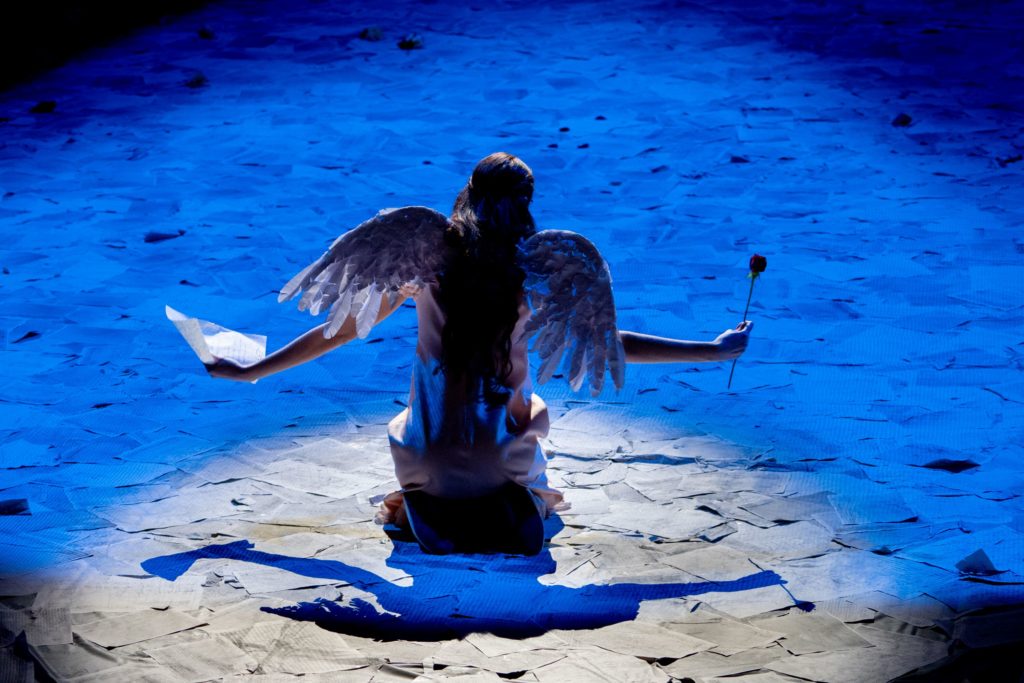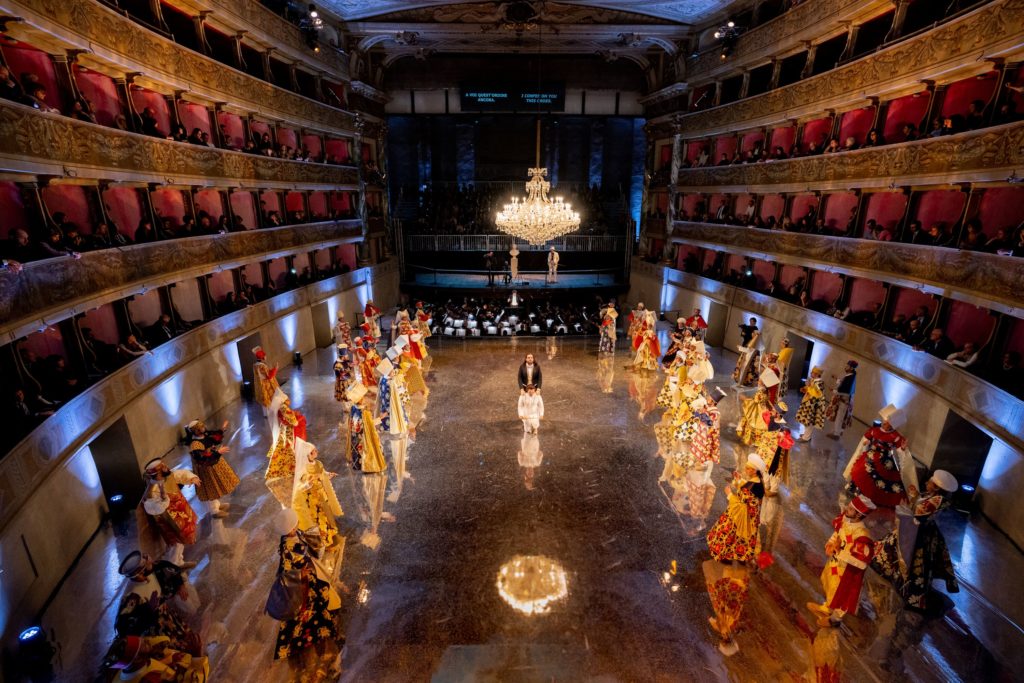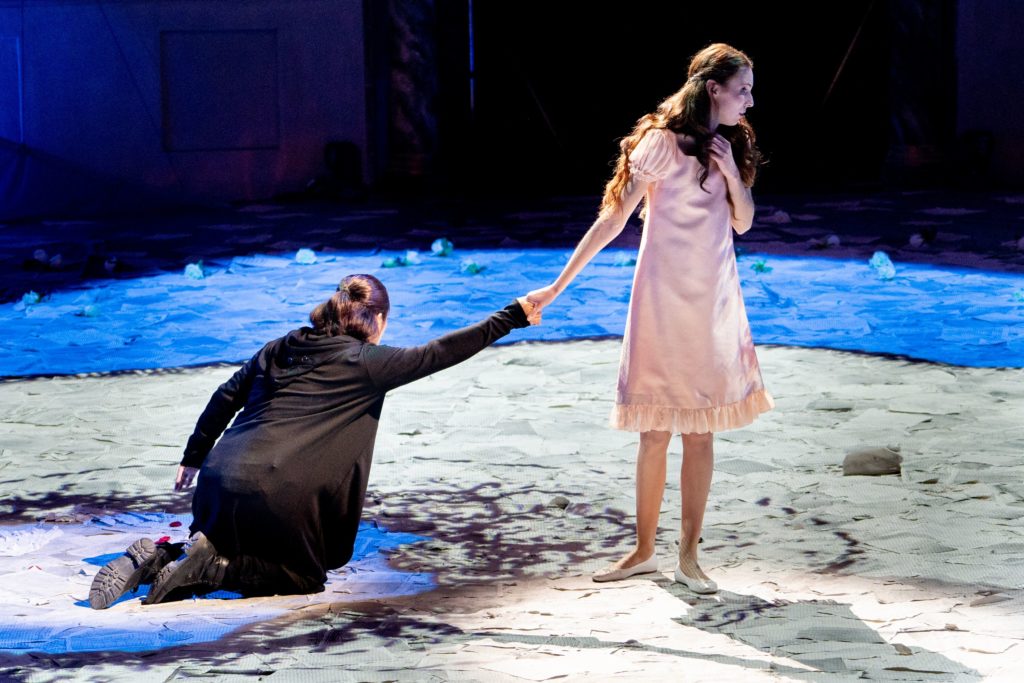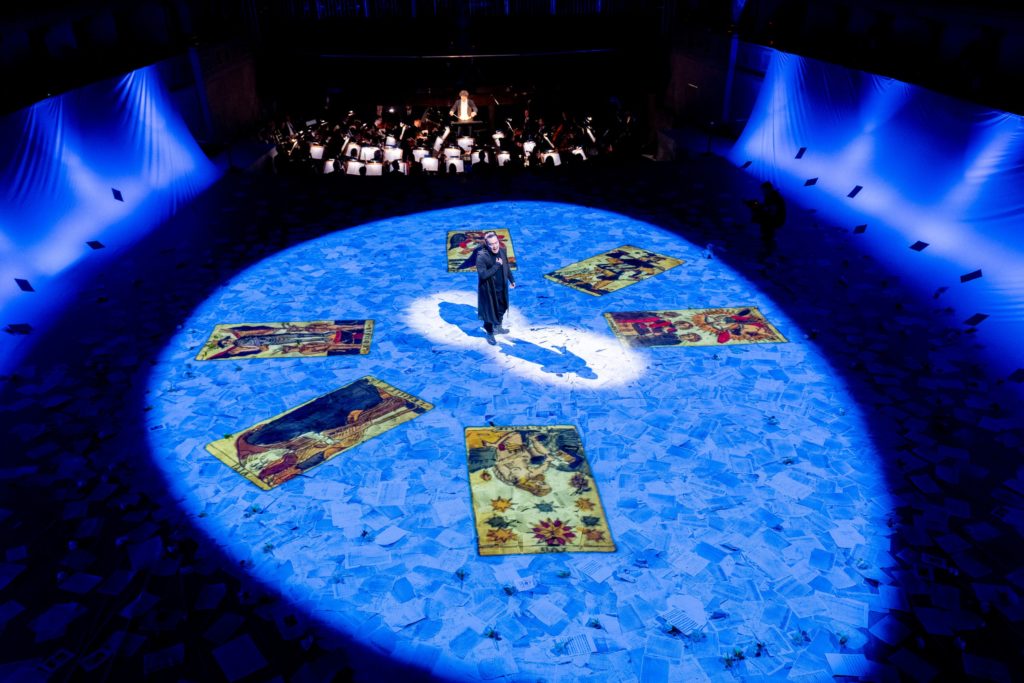
Donizetti Opera Festival 2019 Review: L’Ange De Nisida
A Powerful Evening Led By Lidia Fridman & Konu Kim’s Revelatory Performances
By Francisco SalazarLast year Opera Rara, in co-production with the Royal Opera House, presented the world premiere of Donizetti’s “L’Ange de Nisida,” a work that was written in 1839 for the Théâtre de la Renaissance in Paris. However, when the theatre went bankrupt, the opera was left unperformed and Donizetti used the music that was written for “La Favorite,” one of his most popular works.
After successful concert performances at the Royal Opera and an acclaimed recording, the Donizetti Opera Festival presented the first staged production of the work ever. The result was revelatory at every imaginable level.
The Work
As noted “L’Ange de Nisida’s” music was reworked as “La Favorite,” making the listening experience all the more familiar throughout the recordings. For listeners familiar with “La Favorite,” most will recognize the concertato that ends Act three as well as the entire final duet. Most of the chorus music is also intact and Ines’ interventions in “La Favorite” are performed by the chorus. The score also contains pieces from “Don Pasquale” and the little-known “Adelaide.”
There are, however, a number of pieces that are original to “L’Ange,” such as Sylvia’s double aria in Act three and Leone’s Act four aria. These pieces were eventually replaced in “La Favorite” for “O Mon Fernande” and “Spirito Gentil.”
Another interesting aspect of this work is the way Donizetti was able to interweave the dramatic with the comic through the character of Don Gaspar. In various moments, there is patter incorporated into the music, which is something one might not expect of a dramatic work by the composer. However, this is what makes this opera so unique.
For those that listened to Opera Rara’s release, the company provided a comprehensive analysis of the music and the way it was reconstructed. According to that release, about 97 percent of the music was complete and so therefore for the remaining three percent was based on Donizetti’s other works; for the missing parts Opera Rara used pieces from other Donizetti operas. The pieces in question included the soprano’s aria in Act three which came from “Maria di Rohan” and the overture, which was never written for the opera.
In Bergamo, musicologists attempted to be as faithful to Donizetti’s intentions, eliminating the overture and following the recitatives only written by the composer. For Sylvia’s aria, the production used music that was closer to Donizetti’s manuscripts. While this aria was never complete, Donizetti intended Sylvia to only have a cabaletta and therefore an early manuscript of “La Favorite” was used to complete this missing piece.
By adhering to the composer’s intentions, the transitions could sometimes sound a bit awkward, lacking the recitatives that allow for smoother transitions. However, the ultimate experience and the music was profound and nuanced.

Poetic Location For A Perfect Production
As fate would have it, the work’s unfinished state matched the venue where its premiere would take place. With the Teatro Donizetti under construction and the Teatro Sociale being used for the productions of “Pietro il Grande” and “Lucrezia Borgia,” director Francesco Micheli was left with the task of staging the work in the cantiere of the Teatro Donizetti.
Micheli used his resources to great effect, relying on simplicity and minimalism. The first two acts were made up of a blue tarp covered in pages of music from the score that would eventually split in half at the end of the first part; the last two acts were covered in a shiny floor that was reminiscent of a mirror. The mirror-like figure went on to represent the ball room with the central chandelier in the middle of the action representing the fragile state of the characters.
The costumes used were also simple, particularly those of Leone and Sylvia. Leone first appears in black, eventually changing to white in the final two acts. He is at first the fugitive and imprisoned man who eventually turns into a monk. Meanwhile, Sylvia first appears in angel wings as the people of Nisida hail her as such. But she is soon stripped of these wings, first by the king and then by the church. Her wedding dress is also torn and she appears at the end in white, a reminder of her true purity and innocence. While she is seen as a guilty mistress, in the context of modern times, audiences can also recognize her to be a victim of her circumstances.
Meanwhile, Don Gaspar wears a white suit while the king is in black, representing them as opposing forces. Meanwhile the chorus wears modern clothing during all the scenes, but the wedding. In this scene everyone is dressed in tradition attire that is made up of wrapping paper, representing the formality and superficiality of their involvement. At the beginning everyone appears elegant but once the reality of Sylvia and the king’s affair is revealed, everyone rips off their garb, revealing their modern attire. This coup de théâtre not only shows how frail power is, but also how easily it is to uncover the truth (an idea that undoubtedly resonates in today’s society). At the end of Act three the paper is left on the floor looking like garbage dumped all over the place, a further reminder of how superficial norms are nothing more than filth.
As with the costumes, some of the lighting choices created gorgeous images, particularly the final one. Sylvia lies dead in the middle of the stage, while an angel is projected via blue lights with the cover of Donizetti’s score also showing up. Text throughout the evening was also projected on the floor as well as maps of Nisida and images of kings.
An interesting aspect of the performance was the use of the chorus. During the first two acts where the scenes are more intimate, the chorus was placed in the fourth palco. There they sang their first entrances with the scores in hand; they would eventually throw their music onto the stage. When the king first entered they also threw confetti onto the stage with pictures of the monarch.
The only qualm with the production was the acoustical balance. When the singers turned around to face the opposite side, the sound was not as audible and even a bit muffled. With the chorus at the top of the theater and the orchestra in the pit, it was difficult at times to hear the performers.
The other aspect that was difficult was the subtitles as audience members who were not directly facing the stage could not see the translations.

A Heartbreaking Diva
In the title role, Lidia Fridman was making a triple debut. It was not only her festival debut but also her role debut and the first Donizetti role of her career. The results were impeccable.
From the beginning of the evening her Sylvia was a women scorned by suffering and remorse. There was fragility in all aspects and it seemed that she was prisoner to all the men. Even in her first duet with Konu Kim’s Leone, she attempted to escape his embrace only to fall right to his arms. But the scene that was most telling of her suffering and her imprisonment was her duet with Florian Sempey’s King. Here he took her angel wings off and forced himself onto her. She was no longer that angelic figure that the people of Nisida saw in her. Instead she was the object of the king, with any favor costing her more disgrace.
During the the quartet where she asks the king to liberate Leone from prison she was dressed in an angel costume that was immediately torn by Le moine from the church. Her pain was elevated in Act three during the wedding scene as she was undressed and stripped down to a white gown. Only in the final act did Fridman’s Sylvia act on her impulse and searched for Leone, who had already joined the monastery. But even here she was rejected by Leone’s anger and pain. Only as she sang her last gasps were her pleas for forgiveness accepted.
From a vocal standpoint, she was sublime. At the start of her duet with “Ah! Leone!,” Fridman sang with delicacy upon seeing Kim’s Leone. And as she attempted to dissuade him from his love for her, she gained more weight and warmth in the voice. The timbre obtained a darker hue and her lower notes gained even greater power. In the second part of the duet, “Adieu,” she extended the phrases, relishing each moment as she ascended into the upper range. Both Fridman and Kim’s voices blended particularly well in the second repeat and eventually crescendoing to a memorable forte. Their upper register connected well and filled the hall with beauty and power.
In her subsequent duet with the King, Fridman displayed frailty in the coloratura line, weaving through the complexities of Donizetti’s music and displaying the character’s lack of control over the situation as the king undressed her. Only when she rose to her high notes did her sound elevate to a forte, representing a women shouting in pain as she is taken advantage of.
In her Act two and the Act three ensembles, Fridman soared over the chorus, soloists, and orchestra, her voice displaying increased anguish and increased power with her high notes growing more and more throughout crescendoes.
But her greatest achievement came in her aria and final duet with Leone. In her aria “Leone, Leone! Faut que l’infamie,” the soprano sang with total control of her voice, beginning certain phrases with a beautiful piano and easily crescendoing to a forte. The coloratura lines were also fluid with each note clear on both repetitions. In the second repetition of the aria, Fridman also interpolated various high notes that came out crystal clear and which emphasized the desperation for her fate.
In the final duet with Leone, Fridman sang with anguish, constantly driving the line forward. But here her voice took on a weakened timbre that slowly faded as the duet went on. As she got toward the final lines, she held out each phrase, trying not to let go. It was heartbreaking to hear Fridman’s warmth fade and take on a piano sound that slowly decrescendoed and faded into the theater.

A Shining Tenor
If Fridman was powerful, Konu Kim gave a profound performance filled with different colors and emotions. No one could ever anticipate what Kim would do with the role as he first entered Act one, singing with a bright timbre and giving each phrase a smooth and delicate color. His phrases starting out with a piano sound and would eventually crescendo to a forte with smoothness and facility. That bright optimism could be seen in the aforementioned duet with Sylvia. While Fridman sang with delicacy and darker hues, Kim’s timbre contrasted with gleam, his high notes projecting beautifully into the hall.
That brightness continued into his first aria “Quelle ivresse et quel délire,” a marchlike cavatina. Here, Kim displayed power and heroism in his tone. He did however, show some torment in the B section, singing with a more desperate and breathy timbre, his interpolated high note adding to that desperation. But that happiness for his renewed freedom returned in the ensuing section. That authoritative and controlled vocal quality returned particularly as he ascended into his high notes and a final gleaming B.
During the finale to Act three when Leone discovers that Sylvia is in fact the king’s mistress, Kim sang with desperation, repeating “La maîtresse del re” each time with more fury and agony. The voice rang into the hall with great power and one could understand the suffering that he was conveying.
The final act finally saw the Kim’s Leone turn to a man filled with pain. One of the highlights of the evening was without a doubt his aria, “Hélas! Envolez-vous, beaux songes!” He began the aria with a delicate, piano sound that was reminiscent of a whimper. Then when he was asked to ascend into the higher tessitura, he gave the high notes a forte dynamic that expressed a cry of desperation. At one point he delivered an exquisite mezza di voce that while a display of virtuosity, effectively conveyed how he felt more and more trapped after becoming a monk. This was of course beautifully displayed in the images of kings that continuously appeared and surrounding him.
In his final duet with Sylvia, Kim initially sang with anger, accenting the text and singing with shorter lines. His timbre also took on a heavier and darker hue. But in the final portion part of the duet, his voice returned to that brightness from the beginning and he sang with that same elegance, gorgeous pianos, and gleaming high notes. There was also a tenderness to this moment as his voice harmonized gorgeously with Fridman’s. That would once again turn to torment when Sylvia dies. Kim’s Leone’s final notes were pleas and cries of lament.
If there was one shortcoming in Kim’s performance it was the fact that his voice sounded constrained at times particularly when he began a piano line, his onset a bit harsh. This was most evident in his first entrance and at the beginning of his Act four aria. Still, this is a tenor to look out for in the coming years.

A Solid Supporting Cast
In the role of the King, Florian Sempey brought an imposing baritone to his character.
From the start of the performance, he gave off an air of authority that started to weaken throughout the evening. In the his duet with Sylvia, Sempey brought a refined and controlled timbre that showcased his power over her. He forced Fridman into his arms undressing himself and insinuating forced intercourse.
His coloratura was sung with steadiness and beauty, emphasizing his sense of control. However, he would eventually lose control. That was most demonstrated in the Act two ensemble “”Ah! qu’a-t-il dit?” when the king learns that Sylvia would be forced into exile or a convent. His singing obtained more urgency and more staccato phrasing. During his cabaletta at the end of Act two “Ô mon ange que j’implore,” Sempey maintained a steady line with a evenly balanced tone but there was a sense of desperation in the text, particularly during the repeat when he interpolated a high note. As he looked at his Sylvia, there was anger and pain, which was enhanced at the coda of the cabaletta as he moved the tempo forward and sang with a sense of hopelessness. His duet with Roberto Lorenzi’s Don Gaspar saw a contrasting portrait of a king. Here he was filled with jealousy, singing with accents in stark contrast to Lorenzi, who was more playful in his phrasing.
As Don Gaspar, Roberto Lorenzi gave a comical cynicism to his character entering at the the beginning of the opera and singing with bright staccato lines in his aria “Et vous Mesdames.” As he dispatched the virtuoso phrases he danced in coordinated form alongside the henchmen. One could sense from the start that while he was singing this aria later used for “Don Pasquale,” Lorenzi’s Don Gaspar was an intriguing person up to no good. He was the master moving the pieces and that was even more obvious during the aforementioned Act three duet with the king. Lorenzi controlled the action and everything going on as he took advantage of the king’s emotional state. One has to give credit to Lorenzi for his impeccable stacatto phrases and his clarity with the patter required for this voice. Never did he sound out of breath or dry and his voice always maintained the clarity of timbre.
In the short but crucial role of Le Moine, Federico Benetti sang with striking and booming bass that made an impression in every scene he was in.
A Compelling Orchestra & Chorus
If the cast was top notch, one can not discount the efforts of Jean-Luc Tingaud in the pit. From the onset of the evening, the conductor used swift tempi to create a sense of urgency even if he sometimes took slower tempi in the andantes and cantabile sections.
What makes this work complex is how to balance the comic with the dramatic and Tingaud managed this dance beautifully by giving a brighter color to comedic moments without losing the sarcasm of these sections; this allowed for a consistent shape when those darker hues colored more dramatic moments. That dramatic force was audible in the final Act four duet, which while full of lighter and tender sound also featured urgency with the tremolo from the violins that gave the sense of impending death.
Then there was the use of the held notes and certain spaces that allowed the singers liberties with phrases. This was most noticeable toward the end as Sylvia was about to die. Leone’s final outbreak was also well-supported by the orchestra as Tingaud built the ensemble with consistent crescendoes each time the tenor had a phrase until there was a thunderous outpour. Then the orchestra decrescendoed to a more angelic sound that grew once more to a rousing forte to end the opera.
Overall the orchestra was solid but Tingaud sometimes indulged in slower tempi particularly in the ensemble strettas. It may have added to the drama to give more time to the ensembles but it seemed more French in style than the energetic Italian Bel Canto.
The chorus led by Fabio Tartari was also part of the success of the evening. The changes in character that were conveyed showed their versatility. At the beginning they were boisterous, animated, joyful and prepared for a party, singing with unending energy.
In the third act, the men’s chorus was gossipy, singing in a soft staccato as they were conspiring and entertaining themselves with the secret of Sylvia being the king’s mistress. In the final act the ensemble sang with an angelic tone, bringing the opera to a powerful and heavenly finale.
Overall this was an unforgettable evening that thankfully has been recorded for release through Dynamic and presented Lidia Fridman and Konu Kim as promising figures in the opera world.


